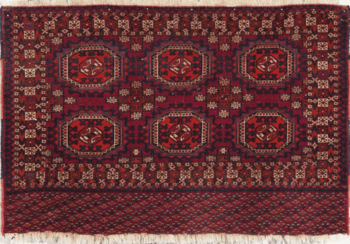Turkmen tribes
The major modern Turkmen tribes are Teke (Tekke), Yomut (Yomud), Ersari (Ärsary), Chowdur (Choudur) and Saryk (Saryq).[1][2] The most numerous are the Teke.[3]

Seljuks, Khwarazmians, Qara Qoyunlu, Aq Qoyunlu, Ottomans and Afsharids are also believed to descend from the early Oghuz Turkmen tribes of Qiniq, Begdili, Yiva, Bayandur, Kayi and Afshar respectively.[4][5][6]
Tribal structure and organization

Turkmen society has traditionally been divided into tribes (taýpalar).[7] Full tribal structure of Turkmens is as follows: halk, il, taýpa, urug, kök, kowum, kabile, aýmak/oýmak, oba, bölük, bölüm, gandüşer, küde, depe, desse, lakam, top, birata, topar, and tire.[8]
The origin of all present-day Turkmen tribes is traced to 24 Oghuz tribes. Khan of Khiva and historian Abu al-Ghazi Bahadur, in his seventeenth century work Shajare-i Tarakime places special importance to the Salur tribe of the Oghuz, since couple of major Turkmen tribes, such as Yomuts and Ersaris derived from it [9]. He claims that the leader of the Salur tribe was Salur Ogurcik Alp[10] who had six sons: Berdi, Buka, Usar, Kusar, Yaycı and Dingli[11].
At the beginning of the 20th century, Feodor Mikhailov, a Russian officer in the military administration of Transcaspian Region of the Russian Empire noted that “all Turkmen, rich and poor, live almost completely alike”. He also added that the Turkmen “put the principles of brotherhood, equality, and freedom into practice more completely and consistently than any of our contemporary European republics.”[12]
The five traditional carpet designs that form motifs in the coat of arms of Turkmenistan and its flag belong to these tribes (and are named after them; for example, "Yomut carpet").[13]
See also
References
- Peyrouse, Sebastien (2015-02-12). Turkmenistan: Strategies of Power, Dilemmas of Development. Routledge. p. 52. ISBN 9781317453260.
- Edgar, Adrienne Lynn (2006-09-05). Tribal Nation: The Making of Soviet Turkmenistan. Princeton University Press. p. 21. ISBN 9781400844296.
- Adle, Chahryar (2005-01-01). History of Civilizations of Central Asia: Towards the contemporary period : from the mid-nineteenth to the end of the twentieth century. UNESCO. p. 47. ISBN 9789231039850.
- "Абулгази - Родословная туркмен". Russian State Library.
- Safa, Z. (1986). PERSIAN LITERATURE IN THE TIMURID AND TÜRKMEN PERIODS (782–907/1380–1501). In P. Jackson & L. Lockhart (Eds.), The Cambridge History of Iran (The Cambridge History of Iran, pp. 913-928). Cambridge: Cambridge University Press.
- « The Timurid and Turkmen Dynasties of Iran, Afghanistan and Central Asia », in : David J. Roxburgh, ed., The Turks: A Journey of Thousand Years, 600-1600. London, Royal Academy of Arts, 2005, pp. 192-200
- Rafis Abazov, "Historical Dictionary of Turkmenistan", p.151
- Soltansha Ataniyazov, “Türkmen Boylarının Geçmişi, Yayılışı, Bugünkü Durumu ve Geleceği” Türk Dünyası Sosyal Bilimler Dergisi, Sayı 10, 1999, pp. 2-3
- Abu al-Ghazi Bahadur, "Shajare-i Tarakime" org. text pp. 207-218 and trans. pp. 267-268.
- Abu al-Ghazi Bahadur, "Shajare-i Tarakime" org. text pp. 207-208 and trans. pp. 264-265.
- Abu al-Ghazi Bahadur, "Shajare-i Tarakime" org. text p. 214 and trans. p. 267.
- F. A. Mikhailov, Tuzemtsy Zakaspiiskoi oblasti i ikh dzhizn, Etnografichestkii Ocherk (Ashkhabad, 1900), pp. 34-50; cited in Edgar, “Genealogy, Class, and "Tribal Policy" in Soviet Turkmenistan, 1924-1934,” p. 272.
- Akyildiz, Sevket; Carlson, Richard (2013-10-15). Social and Cultural Change in Central Asia: The Soviet Legacy. Routledge. p. 165. ISBN 9781134495139.
- Asiatische Studien: Études asiatiques. A. Francke. 2006. p. 459.
Approximately six weeks after securing the capital of Khorezm and most of its territory, von Kaufman ordered General Golovachev to annihilate the Turkmen Yomut tribe in one of the most brutal expeditions of the Khivan campaign.